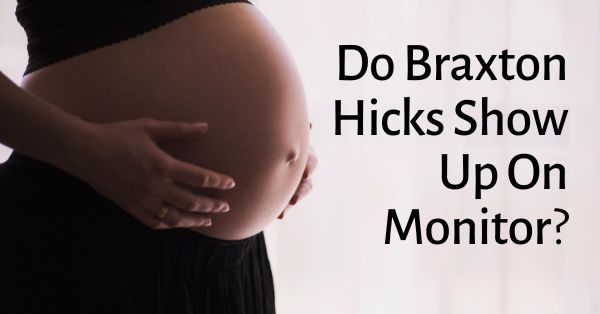My colleague was progressing from trimester to trimester without a hitch. Since she got into her eighth month, she started experiencing Braxton hicks contractions almost weekly. These are mild, uncomfortable period-like cramps that come briefly and go away.
While her doctor recommended using ultrasound to confirm, the contractions were so weak, and she wasn’t sure if the results would be conclusive. Do Braxton Hicks show up on monitor?
Read on to learn more about Braxton hicks and how they are measured.

So Do Braxton Hicks show up on monitor?
Yes. Braxton hicks, like other uterine contractions, show on a monitor. The line at the bottom of your monitor tracks vaginal tightening.
However, the duration and consistency aren’t like that of real contractions. Since Braxton hicks are mild, irregular and random, the monitor registers faint, non-continuous lines without a defined pattern.
What Causes Braxton Hicks?
Also known as false labour, Braxton hicks are labour-like contractions that feel like period cramps but don’t cause dilation of your uterus. They are part of a normal pregnancy in some women.
Let’s find out the possible causes of Braxton hicks.
- Dehydration- hydration relaxes the muscles around your tummy hence preventing Braxton hicks.
- Over-activity – As your belly grows, the skin and muscles in your abdomen stretch. You may feel cramps as muscles get tighter if you do rigorous activities. This explains why most Braxton hicks happen later in the day after finishing your daily duties.
- Lifting heavy weights- Lifting heavy weights strains your uterine walls causing contractions.
- A full bladder- As your baby grows, the bladder gets fuller frequently than before. It may pressure your uterus when it’s full, leading to Braxton hicks.
Why Is It Essential for My Doctor to Check My Braxton Hicks?
Since Braxton hicks majorly occur towards the end of your pregnancy, they can be mistaken for labour. According to All About Women Obstetrics and Gynaecology, every pregnant woman experiences Braxton hicks, but not all are aware of it. It’s wise for your doctor to check them for the following reasons:
- To track the pain/cramps intensity
- To monitor the duration of your contractions
- The examination helps in ascertaining the frequency of Braxton hicks contractions.
Braxton hicks are irregular, less intense, don’t come close together and can’t stop you from going about your typical day.
Conversely, labour is regular, intense, prolonged and painful. Also, labour contractions show a defined pattern on the monitor and may hinder you from walking or doing your chores.
What do Braxton hicks look like on a monitor?
On an electronic foetal monitor, you’ll see a paper graph recording the foetal heart rate (with a blue indicator) and contractions (with a red indicator). When looking at the monitor, the foetal rate often appears on the top while contractions come on the bottom.
The red indicator appears at the bottom to show the strength of a contraction in mmHg- millimetres of mercury. If the millimetres are more, it means the contractions are getting stronger.
Do Braxton hicks mean I’m going into labour?
While Braxton hicks are a sign of your body getting ready for the birth of your baby, they do not always end up in labour. These contractions tone the uterus but don’t cause dilation.
To be safe, watch out for signs of preterm labour any time before 37 weeks. The most common symptoms of labour include:
1. Frequent, regular, close-together contractions/ abdominal tightening.
2. A lower back pain that starts gradually and intensifies with time.
3. A feeling of pressure on your pelvis and lower abdomen.
4. Mild cramps/discomfort in your abdomen.
5. Preterm breaking of water- You may feel a warm fluid gushing out after a popping sensation.
6. Watery, mucus-like, sometimes bloody vaginal discharge.
If you’re asking, “can Braxton hicks be seen on monitor?” your doctor will assist you in interpreting the results.

How to relieve Braxton hicks
Before rushing to your doctor to have the contractions checked on the monitor, the following may help in relieving symptoms:
- Change position- Changing positions from sitting to standing or lying to walking could stop Braxton hicks.
- Take a rest- Avoid overworking your body. Resting and having a warm bath or massage would greatly help. You may also listen to some music, watch a movie or take a nap.
- Hydration- Take lots of fluids to boost hydration hence relieving symptoms of Braxton hicks.
Wrapping Up
Braxton hicks are normal in pregnancy. Towards the third trimester, they may become more regular – often happening daily. While there are no special tests or radiographic assessments to check BH, a foetal monitor greatly helps.
But,
Do Braxton Hicks show up on monitor? Yes, they may be milder than labour contractions, but they are visible at the bottom of a monitor. Though you can manage them at home by avoiding over-activity and relaxing, it’s wise to visit your doctor to ensure you aren’t going into labour.